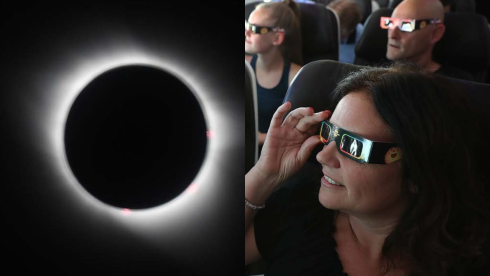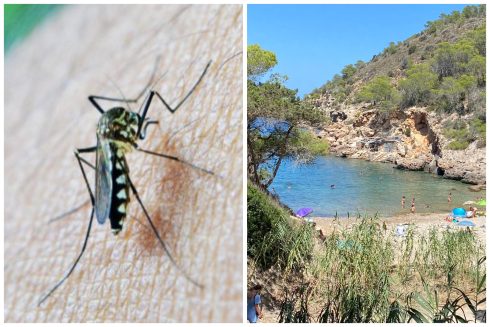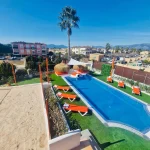Jason Heppenstall spends an idyllic few days on the island of Mallorca – and comes home without his hubcaps
“GUTEN Morgen. Tee oder Kaffee?” the Spanish lady at the breakfast bar asked me. This was not good. I was supposed to be in Mallorca, not Germany. We had arrived the night before in a hire car so small and shiny it resembled a silver pebble on wheels. And now we were sitting in a grand dining hall full of chandeliers and dour faced Teutonic retirees on some sort enforced merriment vacation.
“Couldn’t you have found somewhere better for us to stay?” asked my wife accusingly over platefuls of sauerkraut. I could not see the problem. OK, so perhaps the ambience was not quite as alluring as it could have been but, I protested, there cannot be many places on Mallorca’s exclusive north west coast where one can get a family room with breakfast for as little as 70 euros a night.
And we had a great view over the port of Soller from our eighth-floor room.
After breakfast we squeezed into the pebble and set off for a day’s sightseeing. Before doing so, however, I checked the hubcaps were still in place. In the car rental office the clerk had tried to sell me “hub cap insurance” for 20 euros, which I had declined. At the time I had thought it bizarre but now, everywhere I looked I seemed to see hire cars with naked wheels.
Was it some sort of racket? I was damned if anyone was going to nick my hubcaps.
Soller, where we had chosen to stay, is typical of many Mallorcan towns in that it has a port and also an accompanying town set a few kilometres inland. When one looks at the history of the island it is not difficult to see why this has occurred. Over the aeons, waves of invaders have swept through the Mediterranean, invading and sacking coastal settlements. Mallorca’s violent visitors include the Carthaginians, Romans, Vandals, Byzantines, Moors, Christians and just good old fashioned Jolly Roger toting pirates. As the largest of the Balearics, Mallorca was a prize catch for invaders. This is why the coastal settlements moved inland for protection within the mountainous interior.
And what a mountainous interior it is. The Serra de Tramuntana mountain range runs east west along the north of the island. While not being dramatically high, the mountains are still cloaked in forest and are tall enough to attract a considerable amount of snow in the winter. We had picked the perfect time to visit. The recent heavy rains of late spring had passed, leaving in their wake a profusion of wildflowers and greenery. Having spent the last two years in Andalucia, it was a welcome change to breathe in the cool scent of pine woods and smell the rich earthy soils of this fabled paradise isle.
We drove west along the coast along a road that wound in out of the foothills, passing through idyllic looking villages along the way. I had wanted to visit the village of Deia, it being the adopted home of the English writer and poet Robert Graves. Having recently read the memoirs or Graves’ son William, I was eager to see for my own eyes this seeming idyllic pueblo. I knew things would have changed since the post-war period in which the memoirs were set. These days the small sandstone constructed village is home to numerous jetsetters. Stroll around its steep narrow streets and you might see Michael Douglas or Catherine Zeta Jones nipping out for a barra. Or maybe Richard Branson sketching out plans for world domination on a napkin in the local bar. Or perhaps Claudia Schiffer helping one of the locals catch an errant goat. Or perhaps not.
Olives, yachts and crusty bread
When it appeared round a bend Deia was all I had imagined it to be. A picture perfect scene of stone houses clustered around a hilltop. We rolled into the village but, unable to find a parking spot, found ourselves being flushed through by the considerable traffic of tour buses and motorbikes. Watching the village recede in the rear view mirror we vowed to return on another – quieter – day.
Carrying on, we passed through a landscape dominated by ancient olive trees. Their contorted forms, bulbous and knotted, lent an air of fabulous antiquity to the landscape. I later read some of the trees are reckoned to be thousands of years old. If trees could talk…
We passed through villages with names that sounded foreign even to our Spanish attuned ears. In fact a map of the island yields a profusion of strange sounding places. Banyalbufar, Puigpunyent, Buger, Formentor; each name with a hint of devilishness about it.
That night in the lounge at our hotel, a couple of cabaret singers warbled out the hits of the 1980s in a mixture of Spanish and German (Sperman?). The clientele had been handed bottles of wine each with their name and room number written on it. These bottles were still there, in various states of emptiness, at breakfast the next morning as the bleary-eyed holiday makers munched bacon and eggs in quiet contemplation of another day sitting on an air conditioned tour bus.
Nobody had taken our hubcaps during the night, so it was with a feeling of springy optimism I squeezed the family into the pebble and pointed it eastwards for another day of sightseeing. First of all we stopped in Soller for a coffee. Soller grew rich during the age of fruit barons and contains some very fine mansions that give way to citrus orchards on the outskirts. The town’s atmosphere is very amenable and one can sit in the central plaza with a coffee and watch the old wooden trams rumble past as they make their way to Palma. Set in a bowl between mountains and with a river running through it, the air is clear and warm and, like elsewhere on Mallorca, there is a general feeling of laid back prosperity about the place. In fact, it was with some reluctance that I got back in the car to continue with our journey.
The road heading east meandered along the coast, sometimes dipping inland to pass through yet another idyllic village. One village was even called Shangri La. So far I had not seen any signs of the mass tourism the island is associated with. In fact, driving along the mountain roads it seemed as if we were almost alone. We travelled to a dramatic and unspoiled cape, the Cap de Formentor, at the north-eastern point on the island, passing picture-perfect bays of turquoise water accessible only to those with their own boats.
I looked down jealously at the blissed out yachties sunbathing on the decks of their boats. One day…
A single hotel sits on the cape, the gracious and opulent Hotel Formentor. Sited among luscious gardens, the hotel has attracted the wealthy and famous since it opened in the 1930s. Pictures of former guests are hang on walls; Winston Churchill, Mikhael Gorbachov, Audrey Hepburn. An astonishing picture of Charlie Chaplin in the garden shows him in normal attire and, as such, perfectly unrecognisable. “Maybe we should stay here instead,” I suggested giddily. “What, and spend our entire budget in one night?” replied Michelle.
Hungry children began to complain so we turned the car around and headed slightly further down the coast to the beach resort of Pollenca. Here, it seemed, on a wide sandy bay, were signs of the package tourist industry. We seated ourselves at a quiet beachfront restaurant for lunch. I ordered something known as Mallorcan bread as a side dish, which turned out to be a dry hunk of cob difficult to bite into and even more difficult to like. The waiter assured me it was muy autentico, and I took his word for it. Some activity down at the seafront caught my eye and I went to investigate. The press were in attendance for the launch of the first yacht powered solely on biodiesel and a big fuss was being made of the seven-litre-engine craft’s green credentials. It motored serenely away into the bay, churning the sea in its wake and leaving the onlookers to finish their champagne.
Heading back we detoured inland, passing through Inca and Binissalem. At Inca, shoemaking centre of Spain, we spent an agreeable hour walking along leafy streets. It was getting to be late afternoon but we still had time to drive to Palma, Mallorca’s capital. Again, we suffered the problem of locating a parking spot and found ourselves being swept through the city and able to form only the most rudimentary impression of it. From what we saw, the new part is indistinguishable from any other modern Spanish city: office blocks and shops. The older part, however, looked to be beautifully laid out with small plazas and cafes and is reminiscent, in some way, of Paris. Above this scene looms the impressive and imposing Gothic cathedral. The building has been in place for around 500 years and has benefitted from restoration by the hand of famed architect Antoni Gaudí.
Our handful of days was up and it was not long before I found myself in the car rental office again. “Did you take out hubcap insurance?” quizzed the clerk. “No,” I replied defiantly, proud I had spent five days of my holiday vigilantly guarding four grey plastic disks. “Then you will have to pay for them”. “What?” I was incredulous. “Look,” said the clerk blandly, nodding to the silver pebble in the car park sitting there – sin tapacubos. “What? How???” I was vexed. I had only left it for five minutes…
You read it in the Olive Press first: the great hubcap racket of Mallorca. So if anyone offers you some in a shady bar somewhere, you know where they came from.










I have been in Mallorca several times…and I loved it!
Tourist are really horrible specimens everywhere I guess…:)….and you need to learn a little more about the place to really love it, like being with “autoctonous” and eating where they eat and so.
I live in France in a turistic place as well, and I tell you, is beautiful but there are a lot of tourist-traps…